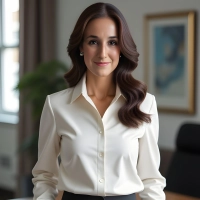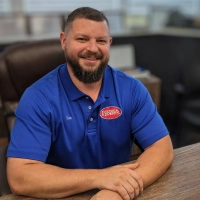25 Ways Small Businesses Can Adapt to Changing Market Conditions
In today's rapidly evolving business landscape, small businesses face unprecedented challenges in adapting to changing market conditions. This comprehensive guide explores X effective strategies, backed by insights from industry experts, to help small businesses navigate and thrive amidst uncertainty. From embracing technological advancements to pivoting business models, these practical approaches offer valuable solutions for small enterprises looking to stay competitive and resilient in dynamic markets.
- Lean Into Change Quickly
- Build Proprietary Frameworks for Scalable Value
- Evolve Core Strengths with New Trends
- Combine Luxury Design with Smart Technology
- Embrace Emerging Green Energy Solutions
- Blend Style with Sun Protection
- Shift from Business-First to Mission-First
- Offer Flexible, Proactive Financial Services
- Adapt Product Offerings to Consumer Needs
- Source Off-Market Properties for Investors
- Pivot to Virtual Cooking Classes
- Focus on Direct-to-Seller Outreach
- Incorporate Flexibility in Property Strategy
- Educate Customers on Cost-Effective Alternatives
- Invest in Digital Marketing and SEO
- Switch to Subscription Model Services
- Embrace Technology for Customer Convenience
- Expand Services to Address Client Needs
- Redirect Funds to Website Development
- Focus on Creating Long-Lasting Organic Channels
- Transform Core Business Practices for Adaptability
- Create Private Spaces for Enhanced Experience
- Diversify Manufacturing to Stabilize Operations
- Shift Focus to Customer Retention
- Secure Strategic Investment from Key Customer
Lean Into Change Quickly
One of the biggest lessons I've learned running Nerdigital is that small businesses survive not by resisting change, but by leaning into it quickly. Early on, I thought "pivot" meant tearing up the entire business model, but over the years I've realized it's often about smaller, strategic shifts that keep you aligned with where the market is moving.
A pivot that proved particularly successful for us came during the early stages of the pandemic. Like many entrepreneurs, I watched in real time as several of our clients slashed budgets and hit pause on long-term projects. My instinct at first was to double down on the same services, just pushing harder. But it became clear that businesses weren't looking for expansive, long-term marketing strategies—they needed immediate, practical solutions that could help them stay afloat.
That realization led us to pivot our focus from broad campaign builds to what I called "survival sprints"—short, intensive projects that delivered fast results, like optimizing sales funnels, strengthening email automation, or repackaging offers for digital-first buyers. It was a shift in scope more than in skillset, but it made all the difference. Clients who were initially on the verge of pausing their work with us leaned in because they saw us adapting to their reality rather than pushing ours.
I'll never forget one client in the hospitality space. They were devastated by cancellations, but instead of trying to sell long-term branding projects, we helped them set up digital gift card campaigns and pivot to online events. It wasn't glamorous work, but it kept revenue trickling in—and, just as importantly, it preserved their customer relationships for when travel returned.
Looking back, that pivot didn't just keep the business alive—it reshaped how we think about agility. We became sharper, faster at listening, and more willing to question whether the services we were offering matched the moment. And even now, years later, that muscle memory of pivoting has stayed with us.
To me, adaptation isn't about having a perfect plan. It's about staying humble enough to admit the old playbook no longer works—and being brave enough to write a new one, even if it's just for the next 90 days.

Build Proprietary Frameworks for Scalable Value
I've adapted my small business to changing market conditions by pivoting from a traditional PR agency model to building proprietary frameworks and ecosystems through Marquet Media and FemFounder. When I noticed that generic PR services were becoming commoditized and harder to differentiate, I leaned into what made my approach unique: the use of structured methodologies. By packaging my expertise into frameworks, digital products, and thought-leadership content, I created scalable value that wasn't dependent on billable hours alone.
A successful pivot occurred during the rise of digital-first entrepreneurship. Instead of chasing large corporate retainers, I focused on helping female founders and small businesses build credibility and visibility through affordable, framework-driven programs and resources. This shift not only opened up a new market but also strengthened my personal brand as a thought leader. The result was more diversified revenue streams, greater resilience during market fluctuations, and a stronger sense of alignment between my business and the people I most wanted to serve.

Evolve Core Strengths with New Trends
When I look back at how Amenity Technologies has navigated changing market conditions, the most defining pivot came during the sudden surge of interest in generative AI. Until then, much of our work was anchored in classical machine learning document parsing, anomaly detection, and geospatial models. Those solutions were still valuable, but the conversation in the market had shifted almost overnight. Clients wanted to know not just whether we could build AI, but whether we could help them harness the new wave of LLMs and retrieval-augmented systems.
Rather than treating it as a distraction, we repositioned it as an opportunity to evolve. We carved out a dedicated internal group tasked with experimenting on generative AI use cases that directly aligned with our clients' industries. At the same time, we embedded training sessions so the whole team could get hands-on with these tools quickly. Within a few months, that pivot allowed us to pitch hybrid solutions combining our existing strengths in structured ML pipelines with the adaptability of generative AI.
The result was not only renewed client interest but also larger, more strategic contracts. What started as a market shock became the bridge that elevated us from being seen as a service vendor to a partner driving innovation. The lesson for me was that pivots work best when you adapt core strengths to new trends, instead of chasing the trend in isolation.

Combine Luxury Design with Smart Technology
When the market started shifting, I noticed more of my clients wanted convenience and technology in addition to beautiful design. In New York, people live fast-paced lives, and their homes and businesses needed to reflect that. That's when I pivoted Vogue Window Fashion from focusing solely on style to really highlighting motorized and automated window treatments. It was a way to keep the luxury look but add an effortless, functional layer that clients now expect.
My favorite example was a young family in Tribeca. They came to me wanting blackout curtains for their kids' bedrooms. Once I showed them how motorized shades could be set to close at bedtime and open gently with the morning light, they ended up incorporating the technology throughout their entire apartment. It gave them privacy, energy savings, and convenience without losing any of the style they wanted.
The same has been true for our commercial clients. When I worked with the Plaza Hotel and the Lotte New York Palace, the original request was for elegant drapery. Once they saw how motorized treatments could help regulate light and temperature while creating a seamless guest experience, they expanded the project to include automated shades across the properties. It's become a way for them to combine design and comfort while also reducing operational costs. By leaning into this demand for automation, we've been able to meet clients where they are, wanting homes and spaces that are both beautiful and easy to live in. That shift has been one of the most successful pivots for my business, keeping us aligned with how New Yorkers live and work today.

Embrace Emerging Green Energy Solutions
The electrical trade has been shifting significantly over the past few years. Between supply chain disruptions, rising material costs, and customers desiring more energy-efficient solutions, we've had to remain flexible.
Focusing on EV charger installations and solar integration work has really paid off for us. A few years ago, most of our jobs were the "bread and butter" tasks such as panel upgrades, rewiring, and lighting. We began seeing more and more customers inquiring about how to prepare their homes for electric cars or add backup power. We trained our team, built relationships with a couple of suppliers, and made it part of our core services.
This shift not only opened up a new revenue stream but also positioned us as the go-to local electricians for forward-thinking upgrades. Customers appreciate that we can handle both traditional work and newer technology, and it helps us stay ahead instead of merely reacting to changes.

Blend Style with Sun Protection
When I first started Tied Sunwear, I realized that more women were paying attention to sun protection, but most UPF clothing felt stiff, bulky, or just not stylish. That's when I decided to pivot, creating pieces that were lightweight, soft, and relaxed, yet still offered UPF 50+ protection without any chemical coatings. Suddenly, women could feel comfortable and confident outside without sacrificing fashion, whether at the beach, pool, or even running errands on a sunny day.
The change that really resonated was highlighting the cooling effect and natural fabric of our pieces in real-life situations. Sharing stories about a customer who stayed comfortable all day at a summer music festival in one of our dresses, or another who felt safe under the sun at the beach in our tunic, helped women see how these clothes could fit into their everyday lives. Framing sun protection as a lifestyle benefit rather than just a safety precaution made a big difference. I also shifted our production to South Korea, which allowed us to maintain consistent quality and UPF standards. Customers notice the difference; they often comment on how soft the fabric feels while still providing reliable sun protection. Knowing our fabrics are independently tested in the U.S. reassures them that their skin is truly protected.
Expanding our digital presence was another key move. Sharing styling tips, behind-the-scenes looks at fabric testing, and honest customer stories helped create a community of women who care about sun safety and style. This direct connection strengthened trust and made people feel part of something bigger than just a clothing brand. By listening closely to our customers and blending style, comfort, and proven protection, Tied Sunwear has grown into more than just sun-protective clothing. It became a way for women to enjoy the sun confidently, stylishly, and safely, which was exactly the pivot that made our business thrive.

Shift from Business-First to Mission-First
The pandemic was a massive market disruption for us. Our entire model was built on in-person care, and suddenly, we couldn't do that. Our marketing plan went from a polished, long-term strategy to a scramble to figure out how to reach people who were isolated and scared. We had to be adaptable, or we weren't going to survive.
My "aha" moment was realizing that our old messaging was useless. Telling people to "come to our center" wasn't relevant when they were stuck at home. The pivot wasn't about a new marketing trick; it was about shifting from a business-first mindset to a mission-first mindset. The new strategy wasn't about marketing; it was about serving.
We immediately changed our message. Our content went from "come get help" to "here's how you can find hope in isolation." We created videos on how to manage anxiety at home and how to find an online support group. We completely stopped trying to sell a service and just started providing resources. We went from advertising our center to advertising a helping hand.
The pivot proved particularly successful. We not only survived; we found a whole new way to help people. We were able to reach people who lived outside of Columbus, people we never could have helped before. My advice is simple: the key to being adaptable in a crisis isn't to change your mission; it's to hold on to your purpose and let go of your plan.
Offer Flexible, Proactive Financial Services
When the market started changing and businesses faced tighter budgets and more uncertainty, I realized our traditional bookkeeping packages weren't flexible enough. Many clients were growing quickly but struggling to keep day-to-day finances in order, and they needed solutions that could adapt with them. So, I shifted to modular bookkeeping packages where clients could pick and choose what they needed each month, whether it was monthly reporting, payroll, tax prep, or a mix. This way, they stayed in control without paying for things they didn't yet need.
The pivot that really worked was introducing virtual consultations alongside real-time bookkeeping dashboards. Before, clients had to wait weeks for updates or rely on reports that didn't reflect their current financial picture. Now, when an e-commerce client had a sudden spike in sales, they could instantly see cash flow projections, make smart purchasing decisions, and avoid overextending themselves.
I also started focusing more on proactive tax planning instead of treating taxes as a once-a-year headache. By looking at things quarterly, clients could optimize deductions and avoid last-minute surprises. A local service business restructured their expense tracking mid-year and ended up saving thousands when filing, freeing up cash for growth. It was a clear example of how ongoing bookkeeping paired with tax planning can make a real difference.
Another small but meaningful change was improving communication. Instead of waiting for emails or monthly calls, we now provide short, focused updates that keep owners informed without overwhelming them. The startup client told me they finally felt confident opening a new branch because they could track expenses in real time, which made all the difference. By making our services more flexible, transparent, and proactive, we've been able to help businesses not just survive market changes but actually plan for growth. This shift to client-focused bookkeeping has become a key way we support our clients, giving them confidence and clarity in their financial decisions.

Adapt Product Offerings to Consumer Needs
When the marketplace changed amid increased inflation, it reaffirmed to me that Cafely, my Vietnamese coffee wellness brand, needed to change very quickly. We simplified our bulk orders to smaller, wellness-based bundles, which seemed very approachable to consumers stretching their budgets. It even gave them a way to stay connected with our product without being priced out. This actually increased our repeat orders, as consumers ordered once and then came back to try different mixes. That pivot also reaffirmed to me that sometimes the best way to grow is not how I scale, but rather to listen closely to see what consumers want in the moment and then change your offering to match their desires.

Source Off-Market Properties for Investors
What adjustments have you made to your small business to account for shifting market conditions? Which pivot turned out to be especially effective?
Since things rarely remain the same for very long in the real estate industry, flexibility becomes essential to success. Focusing on investors who required off-market opportunities was one of my brokerage's most effective pivots during tighter market cycles. Many buyers were irritated by expensive and competitive listings due to rising interest rates and a decrease in MLS inventory. At a time when traditional channels felt closed off, I was able to meet investor demand by sourcing properties directly from motivated sellers and packaging them as below-market opportunities.
I also leaned into design as a performance driver with Rachael's Refined. Properties that stand out both aesthetically and functionally are more appealing to buyers and renters in slower markets. Investors were reassured that their purchases could still turn a profit even in the face of market challenges when even modest properties were elevated through careful staging and interior upgrades, enabling them to sell more quickly and at better price points.

Pivot to Virtual Cooking Classes
When COVID dramatically changed the restaurant landscape, we quickly transformed our business model to meet new customer needs. Our most successful pivot was launching family-style takeout meals paired with virtual cooking classes, which allowed us to maintain revenue while creating new engagement opportunities. This approach not only helped us weather the immediate crisis but also strengthened our community connections as customers appreciated seeing behind-the-scenes content and chef tips through our social channels. The pivot ultimately created a valuable additional revenue stream that we've continued even as in-person dining has returned.

Focus on Direct-to-Seller Outreach
One significant pivot I made was shifting away from chasing deals on the MLS and focusing more on direct-to-seller outreach. When interest rates increased and competition intensified, I realized that waiting for properties to hit the market was no longer effective. Everyone was competing for the same listings, and the numbers rarely worked.
Instead, I started investing more energy into reaching homeowners directly through methods such as SEO on our website, Google Business Profile, and even simple Facebook ads. Initially, it felt somewhat outside my comfort zone, but it turned out to be one of the best decisions I made. Suddenly, I was communicating with people who genuinely wanted to sell their homes, not just tire kickers.
This shift not only provided me with more consistent leads but also made the business feel more under my control. I wasn't just reacting to whatever the market offered; instead, I was building my own pipeline. In retrospect, it was less about implementing a sophisticated strategy and more about being willing to try something new when the old approach stopped working.

Incorporate Flexibility in Property Strategy
What adjustments have you made to your small business to account for shifting market conditions? Which pivot turned out to be especially effective?
Moving from depending solely on short-term visitors to incorporating flexibility into each property's strategy was the most successful change I've ever made. I reorganized some rentals to appeal to mid-term stays—traveling professionals, relocating families, or remote workers seeking longer accommodations—when leisure travel slowed in some markets. In addition to stabilizing occupancy rates, this change also decreased turnover costs, providing owners with more steady revenue streams during periods of pressure on nightly rates.
Because the pivot was based on data and transparency, it was successful. Instead of following a rigid model, we were able to collaborate with owners to make well-informed decisions by presenting them with the financial trade-offs between nightly, weekly, and monthly bookings. It demonstrated that being resilient in real estate doesn't mean adhering to a single formula; rather, it means remaining flexible, using technology to gain insights into pricing, and viewing every property as a distinct asset with several potential routes to success.

Educate Customers on Cost-Effective Alternatives
When lumber prices skyrocketed in 2022, we pivoted from pushing hardwood to educating customers about luxury vinyl alternatives that offer similar aesthetics at stable prices. We created comparison displays showing cost savings over 10 years. This honest approach actually increased customer trust and loyalty - sales of alternative products grew 60% while maintaining our reputation for transparency rather than just chasing higher margins.

Invest in Digital Marketing and SEO
The biggest shift occurred when the market transitioned from the frenzy of multiple offers and bidding wars to a much slower, more balanced environment. As the founder of Vancouver Home Search, I had to make a conscious pivot from being purely opportunity-driven to becoming much more advisory-driven.
Instead of focusing all our energy on fast transactions, I doubled down on education and long-term relationships. We began creating detailed market updates, running seller strategy sessions, and offering more personalized buyer consultations. That helped position us as trusted advisors rather than just salespeople.
One pivot that proved particularly successful was investing in digital marketing and SEO at a much higher level. When the market slowed and buyers/sellers became more cautious, having an online presence that generated steady inbound leads gave us consistency while many agents saw their pipelines dry up. By controlling the flow of conversations rather than relying solely on the market pace, we were able to stay ahead of the curve.

Switch to Subscription Model Services
I adapted my business to changing market conditions by watching customer behavior and industry trends and adjusting accordingly. One pivot that worked well was switching a portion of our services to a subscription model when one-off projects were declining. By offering clients ongoing support and bundled services, we created a more predictable revenue stream and client loyalty. I also invested in digital tools to streamline communication and project management so we could respond faster to client needs and reduce overhead. It not only helped us weather the market shift but opened up new clients who preferred flexible subscription-style services. I learned to be agile, listen to customers, and be willing to rethink traditional business models to grow.

Embrace Technology for Customer Convenience
As a small pest control business, one of the biggest adaptations has been embracing technology and customer convenience. Years ago, most people were comfortable calling in for quotes or waiting for paper invoices, but today everyone wants things faster, easier, and online. We pivoted by upgrading our scheduling system, offering online payment options, and making it extremely simple for customers to request service or a free estimate directly from their phones. That small shift ended up saving us time, reducing missed appointments, and honestly just made life easier for both our team and our customers.
Another significant pivot that has been highly successful was expanding into pest control options that don't require poisons or use them more effectively in smaller quantities. Increasingly, people want peace of mind that we're not indiscriminately applying chemicals everywhere, and that's a concern we understand. Over time, we shifted to using more integrated pest management techniques that go beyond spraying. That not only set us apart from some competitors but also built a tremendous amount of trust with our customers.

Expand Services to Address Client Needs
When market feedback showed us that our initial focus on quick cash offers wasn't addressing our clients' biggest pain points, we made a significant business adjustment. After speaking directly with homeowners dealing with inherited properties, we discovered they were more overwhelmed by the logistics of handling belongings than by financial concerns. We expanded our services to include property clean-out and donation coordination, which addressed their actual needs more effectively than our original model. This pivot not only improved client satisfaction but also created a competitive advantage by solving a problem many in our industry were overlooking.

Redirect Funds to Website Development
The pandemic forced us to completely shift our digital campaign strategy from event-based promotions to website development for conversion optimization. The travel company lost all their bookings during COVID-19, so we redirected their funds to create a mobile-friendly website with built-in direct booking functionality. The website now generates 80% of their total revenue while eliminating all third-party transaction costs.
The experience demonstrated that agility requires more than quick responses because it needs a system that allows changes to occur without causing system collapse. The organization reduced its service stack during that period and decided to maintain the new structure after the crisis.
Focus on Creating Long-Lasting Organic Channels
What adjustments have you made to your small business to account for shifting market conditions? Which pivot turned out to be especially effective?
It takes both agility and discipline to adjust to shifting market conditions. Making the decision to move marketing tactics away from paid acquisition and toward creating long-lasting, organic channels was one of my best decisions. We reorganized our efforts to concentrate on content-driven growth, partnerships, and inbound funnel automation as market conditions tightened and advertising expenses increased. In addition to lowering our cost base, this made the pipeline more robust and less susceptible to ad market volatility.
The more general takeaway is that pivots don't always need to be drastic; sometimes they just involve focusing on what will produce long-term benefits rather than immediate gains. Businesses can put themselves in a position to prosper even in unstable external conditions by focusing on systems that generate compounding returns, such as SEO, relationship-driven sales, and recurring revenue models. The most successful pivot was the one that gave us greater control over our own growth engines and less reliance on the market remaining favorable.

Transform Core Business Practices for Adaptability
When the pandemic threatened our live-event business model, we made the difficult but necessary decision to pivot completely to virtual experiences. This transition required us to reimagine our entire approach to event production while maintaining the quality our clients expected. The pivot not only allowed us to survive the immediate market disruption but unexpectedly resulted in our most profitable period in 14 years of operation. This experience reinforced our belief that adaptability and a willingness to transform core business practices are essential when facing significant market changes.

Create Private Spaces for Enhanced Experience
The pandemic's arrival forced us to redesign every aspect of our buildout, including ventilation systems and personal areas. The spa designers had initially planned shared spaces for the facility until they changed their plan to create separate Beer Therapy Rooms. The decision to create private Beer Therapy Rooms transformed the entire spa experience. The guest expressed to me that the private atmosphere made him feel like he was in his own personal space, which turned out to be our main attraction.
The spa began offering gift options after walk-in customers stopped visiting downtown locations. The initial holiday candle bundle promotion evolved into a massive gift business. The gift card recipients visit our establishment because their friends insisted they must experience our services. The business transformation of slow periods into successful seasons occurred through this strategic change.

Diversify Manufacturing to Stabilize Operations
When Trump's tariffs disrupted global supply chains, our sourcing and manufacturing business pivoted by expanding into Vietnam and Thailand. That diversification stabilized operations and gave our clients more competitive options, which helped us turn what could have been a major threat into a significant opportunity to strengthen our relationships and build trust.

Shift Focus to Customer Retention
For a small business, a sudden market disruption can be a huge threat. We experienced a situation where a major shift in the economy caused our customers to stop spending on big, expensive parts. Our old marketing plan was focused on attracting new, big-ticket business, and it was no longer effective. We had to adapt quickly or risk going out of business.
The pivot that proved particularly successful was shifting our entire focus from customer acquisition to customer retention and community building. The old plan was about attracting new customers. The new plan focused on nurturing and retaining the ones we already had by helping them save money and survive a downturn.
From an operations standpoint, we immediately re-evaluated our inventory. We focused on stocking up on smaller, high-demand items that were more resilient to an economic downturn. From a marketing standpoint, we completely changed our message. We stopped running ads to attract new customers. Instead, we created content that focused on helping our existing customers. We created guides on cost-effective maintenance, videos on how to repair minor issues, and a community forum where our customers could interact with each other. The goal wasn't to sell them a new part; it was to help them save money.
As a result, our sales stabilized. We didn't lose our most loyal customers because we showed them we were a partner, not just a vendor. The biggest lesson was that our marketing strategy needed to be tied to our customers' reality, not just our sales goals. My advice is that the most resilient marketing strategy is one that is built on a foundation of empathy and trust.

Secure Strategic Investment from Key Customer
When market conditions became challenging for our startup, we had to think creatively about funding sources to keep the business afloat. One particularly successful pivot was approaching our largest customer, who had a strong balance sheet, to become an investor in our company. While this arrangement came with some restrictive commercial terms, it provided the capital we desperately needed at a critical juncture. This strategic decision not only saved our business but positioned us for tremendous growth in the following years. Four years after this pivot, we were generating meaningful profits and had established a much stronger market position than would have been possible without this adaptability.




